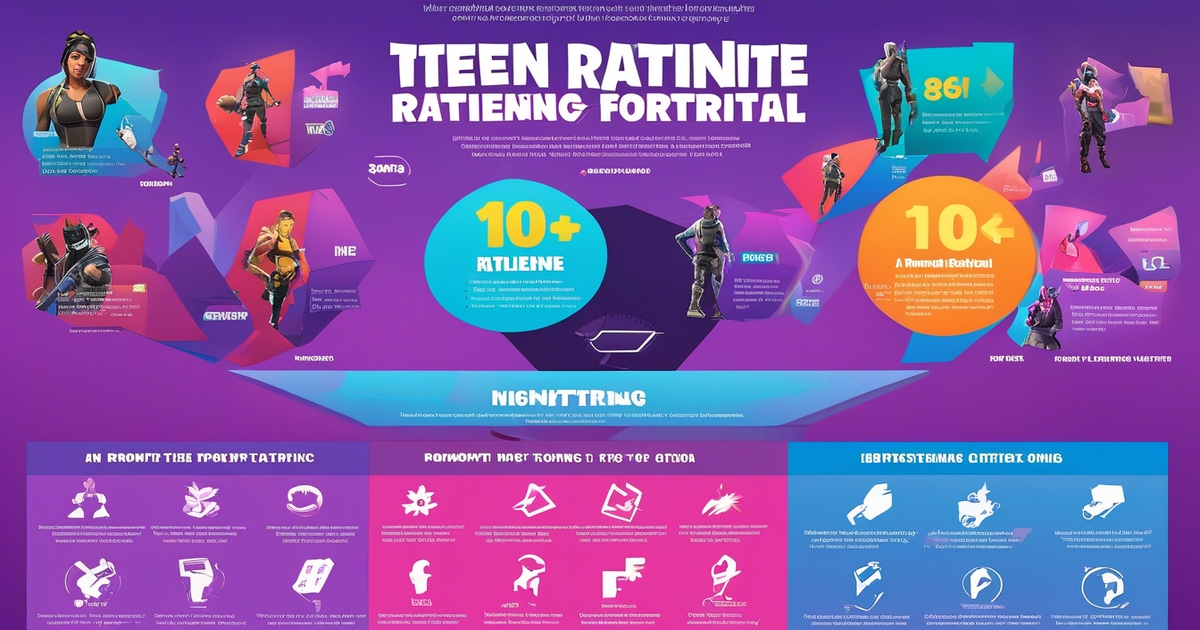Why is Fortnite Rated Teen: Parental Guidance Essentials
Curious about why Fortnite is rated Teen? Understanding the historical context sheds light on this popular game’s age rating. Since its launch in 2017, Fortnite has captured the attention of millions worldwide, especially among younger players. The game’s mix of vibrant graphics, strategic gameplay, and social interaction contributes to its appeal to a broad audience.
Fortnite’s Teen rating by the Entertainment Software Rating Board (ESRB) reflects the game’s content, which may include mild violence and suggestive themes. This classification aims to guide parents and guardians in making informed decisions about their children’s gaming experiences. By exploring why Fortnite carries a Teen rating, players and parents can better comprehend the game’s suitability for different age groups.
Key Takeaways
-
Parental Guidance Essentials: Parents should actively engage with their children who play Fortnite to understand the game, set limits on screen time, and monitor their online interactions.
-
Risk Management Strategies: Encourage young players to take breaks, practice good digital citizenship, and be cautious of in-game purchases to promote responsible gaming habits.
-
Understanding Fortnite: Familiarize yourself with the game’s mechanics, objectives, and social aspects to better comprehend its appeal to teenagers.
-
Teen Rating Explained: The Teen rating for Fortnite indicates mild violence and suggestive themes, making it crucial for parents to assess its appropriateness for their children.
-
Impact on Young Players: Recognize the potential effects of prolonged gaming sessions on children’s behavior, social skills, and academic performance, prompting a balanced approach to gaming.
-
Financial Aspects of Fortnite: Be aware of the in-game purchases and microtransactions within Fortnite that can lead to unplanned spending, emphasizing the importance of financial literacy for young players.
Understanding Fortnite
Game Overview
Fortnite is a highly popular online multiplayer game enjoyed by millions worldwide. Players can engage in different modes such as Battle Royale, Creative, and Save the World. The game is accessible on platforms like PC, consoles, and mobile devices.
Battle Royale Basics
Battle Royale gaming involves multiple players fighting until only one remains standing. In Fortnite Battle Royale, the goal is to be the last player or team alive among 100 participants. Players must scavenge for weapons, build structures for defense, and outlast opponents through skillful gameplay.
Strategic thinking and quick decision-making are crucial in Fortnite Battle Royale. Survival skills play a significant role in determining success, as players navigate the shrinking play area known as the “storm eye” while engaging in intense combat encounters.
Save the World Mode
In Save the World mode, players collaborate in a cooperative gameplay experience to defend against waves of enemies. The mode follows a mission-based structure where players complete objectives to progress through the game. Unlike Battle Royale, Save the World focuses on teamwork and resource management.
The key difference between Save the World and Battle Royale modes lies in their gameplay objectives. While Battle Royale emphasizes elimination and survival tactics, Save the World encourages teamwork, base-building, and strategic planning to achieve mission success.
Solo vs Team Play
When playing solo in Fortnite, individuals rely solely on their skills to survive and emerge victorious. On the other hand, team play allows for collaboration with friends or other online players to achieve common goals efficiently. Teamwork offers advantages such as shared resources, coordinated attacks, and increased chances of victory.
In solo play, players must be self-reliant and adapt quickly to changing situations without external support. Conversely, team play fosters communication, coordination, and division of tasks among teammates to maximize efficiency and effectiveness on the battlefield.
Teen Rating Explained
Content Criteria
Fortnite’s Teen rating is primarily due to its cartoony graphics and mild violence, making it suitable for a teenage audience. The game features animated blood but lacks realistic gore, aligning with the age-appropriate content guidelines.
Violence Assessment
The level of violence in Fortnite is considered mild and non-realistic, featuring cartoony animations that reduce the intensity of combat. Concerns about the impact of violence on players are addressed through the game’s stylized approach.
Language and Interactions
In Fortnite, players engage in battles using a combination of visual cues and text-based communication. The language used is generally light-hearted, focusing more on gameplay strategies rather than explicit content. Interactions between players are monitored to maintain a positive gaming environment.
Age Suitability
Fortnite’s gameplay mechanics and overall tone make it suitable for teenagers aged 13 and above, as indicated by its Teen rating. While younger children may be drawn to the game, parents are advised to consider the level of violence and online interactions before allowing them to play.
Impact on Young Players
Psychological Effects
Playing Fortnite can have various psychological effects on young players. The intense gameplay and competitive nature of the game can lead to increased levels of stress and anxiety among players. Spending excessive amounts of time playing video games like Fortnite can result in decreased social interaction and physical activity, which are crucial for overall mental well-being. It’s essential for parents to monitor their children’s gaming habits and ensure they maintain a balance between gaming and other activities.
Social Interaction
Fortnite offers young players the opportunity to engage in social interactions within the game. Through features like voice chat and team gameplay, players can communicate with others, make friends, and build teamwork skills. These social interactions can enhance communication abilities and foster positive relationships among players. Encouraging children to play with friends they know in real life can also promote safer online interactions.
Gaming Addiction
Gaming addiction is a serious concern associated with games like Fortnite, especially among young players. Signs of addiction include neglecting responsibilities, withdrawal symptoms when not playing, and a preoccupation with the game. To prevent gaming addiction, it’s crucial to set limits on screen time, encourage breaks during gameplay, and promote diverse recreational activities. Parents should be vigilant about monitoring their children’s gaming behavior and seek professional help if addiction signs emerge.
Parental Guidance Essentials
Setting Boundaries
Setting boundaries for gaming is crucial for parents to ensure a healthy balance in their child’s life. Establishing clear limits on when and how long your child can play Fortnite can help prevent addiction and promote other activities. Encourage breaks and engage in non-gaming activities together.
Managing Screen Time
To manage screen time effectively, parents can set specific time limits for playing Fortnite each day. Excessive screen time can lead to various health issues like eye strain and poor posture. Encourage your child to take regular breaks during gaming sessions to rest their eyes and stretch their muscles.
Enabling Parental Controls
Parents can enable parental controls on Fortnite to monitor and restrict their child’s gameplay. By setting up controls, you can limit the amount of time spent playing, regulate in-game purchases, and block inappropriate content. Step-by-step instructions for enabling parental controls are available on the game’s website or through the console settings.
Fortnite’s Online Environment
Chat Features
In Fortnite, voice chat stands out as a crucial feature for players to communicate effectively during gameplay. This feature enables real-time conversations, enhancing teamwork and strategizing. Players can coordinate their moves, share information, and react promptly to in-game situations.
Voice chat in Fortnite also presents challenges, such as the potential for inappropriate language. Some players may use offensive or vulgar language during interactions, leading to discomfort for others. This issue highlights the importance of monitoring and regulating communication within the game environment.
Voice Chat Options
To disable voice chat in Fortnite, players can navigate to the settings menu and toggle off the voice chat option. This step ensures a more controlled gaming experience, especially for younger players or those sensitive to explicit language. Alternative communication methods like text chat or emotes offer viable substitutes for voice chat.
Disabling Voice Chat
Players may opt to disable voice chat due to various reasons, including privacy concerns, unwanted distractions, or a desire for a quieter gaming experience. By turning off voice chat, individuals can focus solely on gameplay without external disruptions. The availability of other communication channels ensures that players can still interact effectively with their teammates.
Twitch Integration
Fortnite’s integration with Twitch, a popular streaming platform, allows players to broadcast their gameplay live to audiences worldwide. Streaming on Twitch offers numerous benefits, including building a community of followers, showcasing gaming skills, and engaging with viewers through live chats.
Setting up Twitch integration for Fortnite involves linking your Epic Games account with Twitch and configuring stream settings within the game interface. By streaming gameplay on Twitch, players can share their experiences with a wider audience, receive feedback from viewers, and potentially gain recognition within the gaming community.
Financial Aspects of Fortnite
Cost Overview
Fortnite operates on a free-to-play model, meaning anyone can download and enjoy the game without any initial cost. This accessibility has contributed significantly to its massive player base. The game’s revenue primarily comes from optional purchases, such as cosmetic items like skins, emotes, and gliders. These items do not provide any competitive advantage but allow players to customize their in-game appearance.
Players can choose to spend money on V-Bucks, the in-game currency used for purchasing these cosmetic items. V-Bucks can be bought with real money or earned through gameplay progression. This system ensures that players have the flexibility to decide whether they want to invest in the game or solely enjoy it for free.
In-Game Purchases
In Fortnite, in-game purchases play a significant role in sustaining the game’s development and updates. These purchases range from cosmetic items like outfits and weapon skins to battle passes that unlock additional challenges and rewards throughout the season. While these purchases are optional, they enhance the overall gaming experience for players who choose to invest in them.
The availability of various types of items for purchase caters to different player preferences. Some players enjoy collecting rare skins or emotes, while others focus on completing challenges within the battle pass. However, concerns have been raised about the potential impact of in-game purchases on gameplay balance and fairness. Critics argue that players who spend more money may have an advantage in terms of visual aesthetics but not in actual gameplay mechanics.
Seasonal Updates and Events
Explaining Fortnite Seasons
Fortnite introduces new seasons every few months, each lasting around 10 weeks, bringing fresh content and changes. These seasons revamp the game’s landscape, introducing new locations, weapons, and challenges. Players eagerly anticipate these updates for a renewed gaming experience. The seasonal concept keeps the game dynamic and engaging.
The changes in Fortnite seasons are not merely cosmetic; they often include gameplay alterations like new mechanics or items that shake up strategies. Alongside these updates, players can engage in season-specific challenges to earn unique rewards like skins, emotes, or V-Bucks. This incentivizes continued gameplay throughout the season.
Live Event Highlights
e of the most memorable live events in Fortnite include the Butterfly Event, where a giant butterfly emerged from a rift, stunning players worldwide. Another iconic event was the Travis Scott concert, a groundbreaking virtual experience that blurred the lines between gaming and music. These events foster a sense of community among players globally.
Live events in Fortnite have a profound impact on the game’s community, fostering excitement and camaraderie among players who gather to witness these spectacles together. They create shared experiences that transcend individual gameplay sessions, forming lasting memories for participants. The anticipation leading up to these events builds a sense of unity within the player base.
Platform Availability
Compatible Devices
Fortnite is accessible on various devices, including PCs, consoles, and mobile phones. Players may enjoy the game on multiple platforms, ensuring flexibility in gameplay. The ability to check Fortnite’s compatibility with different devices is crucial for a seamless gaming experience.
- Compatible Devices:
- PCs (Windows, macOS)
- Consoles (PlayStation, Xbox, Nintendo Switch)
- Mobile Phones (iOS, Android)
The cross-platform capabilities of Fortnite allow players to connect and play together across different devices. This feature enhances the gaming experience by enabling friends to join forces regardless of their chosen platform. Cross-platform play promotes inclusivity and fosters a sense of community among players.
In multiplayer gaming, device compatibility plays a significant role in ensuring fair and enjoyable gameplay. It eliminates barriers that may arise from using different devices, creating a level playing field for all participants. Compatibility also enhances communication and teamwork among players during intense battles.
Cross-Platform Play
Cross-platform play in Fortnite enables gamers to team up with friends on various devices, enhancing social interactions and collaboration. Playing with friends on different platforms opens up new opportunities for shared experiences and challenges.
The benefits of cross-platform play extend beyond mere gameplay; it strengthens bonds between players who can now compete and strategize together regardless of their chosen device. Despite concerns about fairness and competition in cross-platform matches, Fortnite’s matchmaking system strives to maintain balance by considering skill levels rather than the platform used.
Risk Management Strategies
Understanding Online Risks
Online gaming, such as Fortnite, can expose players to various potential online risks. Cyberbullying is a prevalent issue in online gaming communities, where players may face harassment or intimidation from others. The presence of online predators poses a threat to young gamers who interact with strangers during gameplay. To mitigate these risks, it’s essential for players to be cautious and mindful of their interactions while gaming.
Staying safe while playing Fortnite involves implementing certain tips and strategies. Players should avoid sharing personal information with strangers they meet online and refrain from engaging in conversations that make them uncomfortable. It’s crucial to report any instances of cyberbullying or suspicious behavior to the game moderators for immediate action. By being vigilant and proactive, players can create a safer gaming environment for themselves and others.
Encouraging Safe Play
Promoting safe play in Fortnite requires establishing clear guidelines and boundaries. Emphasizing the importance of respect and sportsmanship can foster a positive gaming culture where players treat each other with kindness and consideration. Encouraging fair play and discouraging toxic behavior helps create a more enjoyable experience for everyone involved.
Parents and guardians play a significant role in ensuring their children engage in safe gaming practices while playing Fortnite. Monitoring screen time, setting limits on gameplay, and discussing online safety measures are crucial steps parents can take to safeguard their children’s well-being. By actively participating in their children’s gaming experiences, parents can guide them towards making responsible choices and navigating potential risks effectively.
Final Remarks
After delving into the intricacies of Fortnite’s Teen rating, its impact on young players, parental guidance essentials, online environment, financial aspects, seasonal updates, platform availability, and risk management strategies, you now have a comprehensive understanding of why this game is deemed suitable for teenagers. Remember to stay informed about the content your children engage with, set boundaries, and encourage open communication regarding their gaming habits. By implementing effective strategies and staying involved in your child’s gaming experiences, you can ensure a safe and enjoyable environment for them to explore Fortnite and other online activities.
Take charge of your child’s gaming journey by applying the insights gained from this exploration. Your active involvement can shape their gaming habits positively and foster a healthy relationship with digital entertainment. Stay vigilant, stay engaged, and empower your child to navigate the virtual world responsibly. Now go ahead and put these learnings into action!
Frequently Asked Questions
Why is Fortnite rated Teen?
Fortnite is rated Teen due to its cartoonish violence, mild language, and online interactions. The game involves shooting opponents with colorful weapons without realistic blood or gore, making it suitable for teenagers aged 13 and above.
What are the financial aspects of Fortnite?
Fortnite follows a free-to-play model where players can purchase in-game items like skins, emotes, and battle passes using V-Bucks currency. This system allows players to customize their gaming experience while supporting the game’s continuous development through microtransactions.
How does Fortnite’s online environment impact young players?
Fortnite’s online environment fosters social interaction, teamwork, and strategic thinking among young players. However, it also exposes them to potential risks such as cyberbullying, inappropriate language, and online predators. Parental guidance and monitoring are essential to ensure a safe gaming experience.
Are there specific risk management strategies recommended for Fortnite players?
To mitigate risks associated with playing Fortnite, it is advisable for parents to set time limits on gaming sessions, educate children about online safety practices, monitor their in-game interactions, and encourage open communication about any concerns or experiences encountered while playing the game.
What platforms is Fortnite available on?
Fortnite is available on various platforms including PC, Mac, PlayStation, Xbox, Nintendo Switch, iOS devices, and Android devices. This wide availability enables players to enjoy the game across different devices and engage with friends regardless of their preferred gaming platform.







